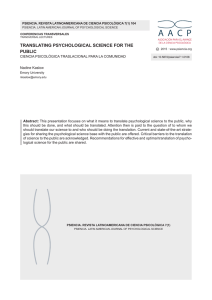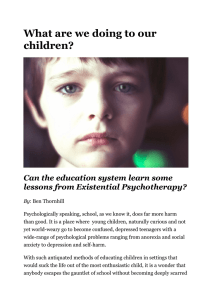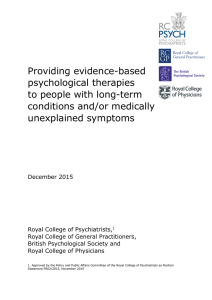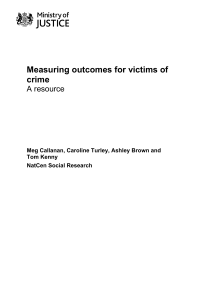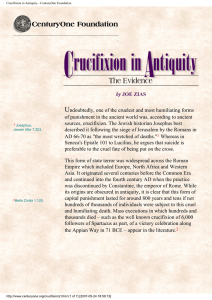evaluation of psychological harm in the victims of violent crime
Anuncio
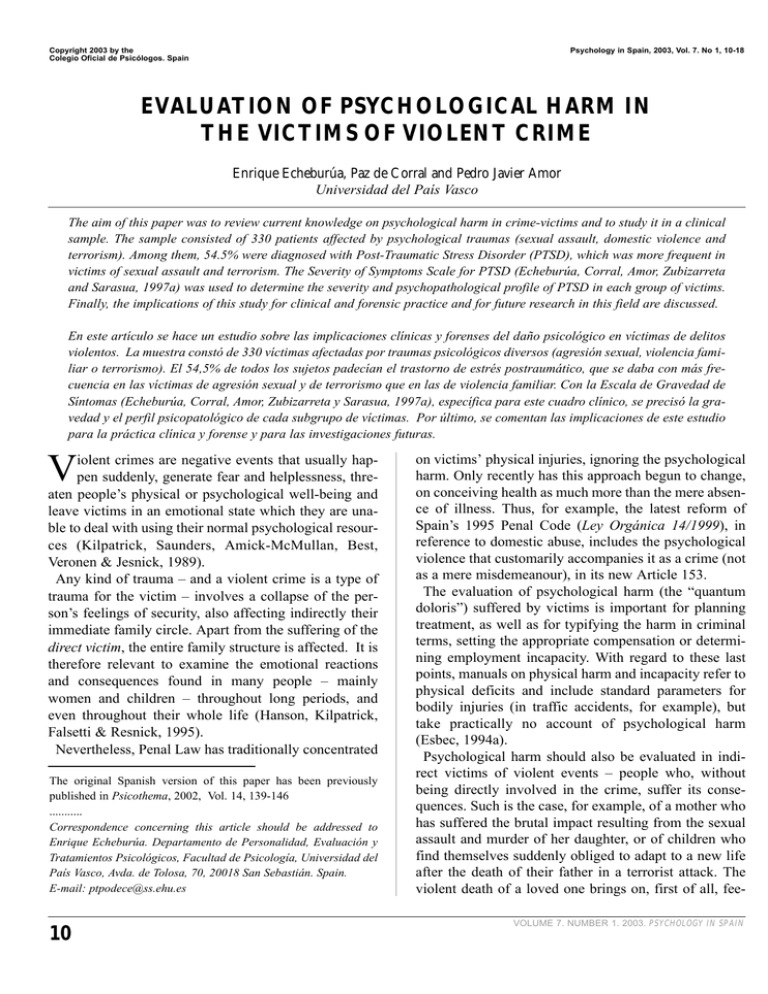
Copyright 2003 by the Colegio Oficial de Psicólogos. Spain Psychology in Spain, 2003, Vol. 7. No 1, 10-18 EVALUATION OF PSYCHOLOGICAL HARM IN THE VICTIMS OF VIOLENT CRIME Enrique Echeburúa, Paz de Corral and Pedro Javier Amor Universidad del País Vasco The aim of this paper was to review current knowledge on psychological harm in crime-victims and to study it in a clinical sample. The sample consisted of 330 patients affected by psychological traumas (sexual assault, domestic violence and terrorism). Among them, 54.5% were diagnosed with Post-Traumatic Stress Disorder (PTSD), which was more frequent in victims of sexual assault and terrorism. The Severity of Symptoms Scale for PTSD (Echeburúa, Corral, Amor, Zubizarreta and Sarasua, 1997a) was used to determine the severity and psychopathological profile of PTSD in each group of victims. Finally, the implications of this study for clinical and forensic practice and for future research in this field are discussed. En este artículo se hace un estudio sobre las implicaciones clínicas y forenses del daño psicológico en víctimas de delitos violentos. La muestra constó de 330 víctimas afectadas por traumas psicológicos diversos (agresión sexual, violencia familiar o terrorismo). El 54,5% de todos los sujetos padecían el trastorno de estrés postraumático, que se daba con más frecuencia en las víctimas de agresión sexual y de terrorismo que en las de violencia familiar. Con la Escala de Gravedad de Síntomas (Echeburúa, Corral, Amor, Zubizarreta y Sarasua, 1997a), específica para este cuadro clínico, se precisó la gravedad y el perfil psicopatológico de cada subgrupo de víctimas. Por último, se comentan las implicaciones de este estudio para la práctica clínica y forense y para las investigaciones futuras. V iolent crimes are negative events that usually happen suddenly, generate fear and helplessness, threaten people’s physical or psychological well-being and leave victims in an emotional state which they are unable to deal with using their normal psychological resources (Kilpatrick, Saunders, Amick-McMullan, Best, Veronen & Jesnick, 1989). Any kind of trauma – and a violent crime is a type of trauma for the victim – involves a collapse of the person’s feelings of security, also affecting indirectly their immediate family circle. Apart from the suffering of the direct victim, the entire family structure is affected. It is therefore relevant to examine the emotional reactions and consequences found in many people – mainly women and children – throughout long periods, and even throughout their whole life (Hanson, Kilpatrick, Falsetti & Resnick, 1995). Nevertheless, Penal Law has traditionally concentrated The original Spanish version of this paper has been previously published in Psicothema, 2002, Vol. 14, 139-146 ........... Correspondence concerning this article should be addressed to Enrique Echeburúa. Departamento de Personalidad, Evaluación y Tratamientos Psicológicos, Facultad de Psicología, Universidad del País Vasco, Avda. de Tolosa, 70, 20018 San Sebastián. Spain. E-mail: ptpodece@ss.ehu.es 10 on victims’ physical injuries, ignoring the psychological harm. Only recently has this approach begun to change, on conceiving health as much more than the mere absence of illness. Thus, for example, the latest reform of Spain’s 1995 Penal Code (Ley Orgánica 14/1999), in reference to domestic abuse, includes the psychological violence that customarily accompanies it as a crime (not as a mere misdemeanour), in its new Article 153. The evaluation of psychological harm (the “quantum doloris”) suffered by victims is important for planning treatment, as well as for typifying the harm in criminal terms, setting the appropriate compensation or determining employment incapacity. With regard to these last points, manuals on physical harm and incapacity refer to physical deficits and include standard parameters for bodily injuries (in traffic accidents, for example), but take practically no account of psychological harm (Esbec, 1994a). Psychological harm should also be evaluated in indirect victims of violent events – people who, without being directly involved in the crime, suffer its consequences. Such is the case, for example, of a mother who has suffered the brutal impact resulting from the sexual assault and murder of her daughter, or of children who find themselves suddenly obliged to adapt to a new life after the death of their father in a terrorist attack. The violent death of a loved one brings on, first of all, feeVOLUME 7. NUMBER 1. 2003. PSYCHOLOGY IN SPAIN lings of pain, sadness, impotence and anger; in a second stage, the most prominent feelings are of pain and impotence; ultimately, those left behind feel pain and loneliness (feelings that do not necessarily improve with time) (Finkelhor & Kendall-Tackett, 1997). WHAT IS PSYCHOLOGICAL HARM? Psychological harm refers, on the one hand, to the acute psychological damage resulting from a violent crime, and which, in some cases, may subside with the passage of time, with social support or with appropriate psychological treatment; and, on the other hand, to the emotional consequences that persist in a chronic fashion and interfere negatively with the person’s everyday life (Table 1). In either case the psychological harm is the consequence of a negative event that produces a new situation with which the victim is unable to cope and to which he or she is incapable of adapting (Pynoos, Sorenson & Steinberg, 1993). What usually generates psychological harm is the threat to one’s own life or psychological well-being, a serious physical injury, the perception of the harm as intentional, the violent loss of a loved one or exposure to the suffering of others, all the more so if they are loved ones or defenceless people (Green, 1990). The harm generated tends to be greater if the consequences of the criminal act are multiple, as occurs, for example, in the case of sexual assault with robbery or in that of a kidnapping that ends in the payment of a high ransom by the victim’s family. If a victim suffers psysical injuries in a violent attack, then the psychological harn suffered is greater. However, serious injuries often result in a better psychological prognosis than less serious injuries, since, in the first case, people are more readily conceived of as victims, and therefore receive more social and family support. As far as indirect victims are concerned, the psychological harm experienced is comparable to that of direct victims, unless the latter have also suffered physical injuries. In the case of terrorism, the psychopathological effects on the indirect victim are greater when the direct victim survives the attack, but is severely disabled and in need of constant care, than when he or she is killed. Psychological harm tends to pass through different phases. In a first stage there is usually a reaction of being overwhelmed, with a clouding of awareness and general bewilderment, characterized by slowness, general dejection, disbelief and lack of ability to react appropriately. In a second phase, as awareness sharpens and the bewilVOLUME 7. NUMBER 1. 2003. PSYCHOLOGY IN SPAIN derment produced by the state of shock dissipates, more dramatic emotional reactions appear: pain, indignation, anger, impotence, guilt, or fear, alternating with periods of profound dejection. Finally, there is a tendency for Flashbacks, either spontaneously or as a result of a stimulus specifically associated with it (a bell, a noise, a smell, etc.), or of a more general stimulus: a violent film, the anniversary of the crime, Christmas, etc. Psychological harm must always be considered in relation to the trauma experienced, independently of other individual variables (previous psychopathology, vulnerable personality, etc.) or biographies (divorce, work stress, etc.). Assessment of the harm can be made in accordance with categories of incapacity and disability (Esbec, 2000). a) Psychological damage Psychological damage refers to an acute clinical alteration a person suffers as a consequence of having been the victim of a violent crime, and which significantly incapacitates him or her in relation to everyday demands at a personal, work, family or social level. This concept of psychological damage, measurable by means of the appropriate evaluation instruments, has substituted that of moral damage, a more imprecise, subjective concept that implies a personal perception of detriment to the non-material qualities of honour or freedom rather than actual psychological suffering. The most common types of psychological damage are Table 1 Psychological harm in victims of violent crime (Esbec, 2000, modified) √ Negative feelings: humiliation, shame, guilt or anger. √ Anxiety. √ Constant worry due to the trauma, with a tendency for flashbacks. √ Depression. √ Progressive loss of personal confidence as consequence of the feelings of helplessness and despair. √ Decrease in self-esteem. √ Loss of interest and concentration with regard to activities previously enjoyed. √ Changes in the system of values, especially confidence in others and the belief in a just world. √ Hostility, aggressiveness, drug and alcohol abuse. √ Modification of relationships (emotional dependence, isolation) √ Increase in vulnerability, with fear of living in a dangerous world, and loss of control over one’s own life. √ Drastic change in lifestyle, with fear of going to the usual places; urgent need to change place of residence. √ Alterations in rhythm and amount of sleep. √ Sexual dysfunction. 11 adaptive disorders (depressed or anxious mood), posttraumatic stress disorder (PTSD) and the imbalance of an anomalous personality. More specifically, at a cognitive level, the victim may feel confused and find it difficult to make decisions, overwhelmed by a profound perception of helplessness (being at the mercy of all sorts of dangers) and lack of control (over his/her own life and future); at a psychophysiological level, victims may be startled easily and frequently; and at a behavioural level, they may be apathetic and find it difficult to return to everyday life (Acierno, Kilpatrick & Resnick, 1999). b) Emotional consequences Emotional consequences refer to the stabilization of psychological harm, that is, to a permanent incapacity that does not subside with the passage of time, nor with treatment. This constitutes an irreversible alteration of normal psychological functioning, or in legal but conceptually less precise terms, an impairment of mental health. The most common psychological consequences in victims of violent crime involve the permanent modification of personality (CIE 10, F62.0), with, the appearance of new, stable and maladaptive personality traits (such as emotional dependence, suspiciousness or hostility) that persist for at least two years and lead to a deterioration of interpersonal relationships and performance at work (Esbec, 2000). This transformation of the personality may be a chroFigure 1 Aspects related to psychopathological vulnerability VULNERABILITY - Psychological - Biological NEGATIVE EXPERIENCES PSYCHOLOGICAL HARM IN VICTIMS OF VIOLENCE INAPPROPRIATE COPING STRATEGIES 12 INSUFFICIENT FAMILY AND SOCIAL SUPPORT nic state or an irreversible consequence of PTSD (F43.1) that arises as the consequence of having been the victim of a violent crime (Echeburúa, Corral & Amor, 2000). The difficulty of assessing emotional consequences is attributable to the post hoc nature of the evaluation – in which it is not always easy to establish the psychological harm to the victim’s previous emotional stability – and to the need to decide between the prognoses of curability and incurability. THE PROBLEM OF CAUSALITY It is often difficult to make the connection between psychological harm suffered now and the violent event experienced previously. However, the establishment of a causal relationship between the violent crime and the psychological damage is essential for making decisions about criminal and civil responsibility, in accordance with Spanish legislation on assistance for victims of violent crimes and sexual assault (Ley de Asistencia a las Victims de Delitos Violentos y de Agresiones Sexuales, Ley 35/1995) and victims of terrorism (Ley de Asistencia a las Victims de Terrorismo, Real Decreto 1211/97). The causal relationship, far from being simple, is often confused by the involvement of ancillary causes, which, unlike causes, are necessary, but not sufficient, for generating psychological harm. Ancillary causes may be preexisting, associated with a vulnerability factor in the victim (as in the case of an adult woman recently raped and who suffered sexual abuse in childhood), simultaneous (as in the case of having contracted AIDS in a sexual assault) or subsequent (as in the case of one’s child having suffered sexual assault or violent death, and one’s subsequent divorce); the last of these types involves a complication of the clinical condition as a result of a complex victimization situation (Esbec, 1994a, 2000). PSYCHOLOGICAL VULNERABILITY It is important not to confuse risk factors, which refer to the features of a victim that make him or her more attractive to a potential aggressor (being female, being young, living alone, having consumed excessive alcohol or drugs, having a condition of mental deficiency, etc.) with psychological vulnerability, which refers to the precariousness of emotional balance, nor with biological vulnerability, which refers to a lower threshold of psychophysiological activation. Both types of vulnerability can increase the psychological harm caused in the victim by the crime. In short, risk victims have a certain predisposition to become victims of a crime because they constitute an easy target for the aggressor; vulnerable VOLUME 7. NUMBER 1. 2003. PSYCHOLOGY IN SPAIN victims, on the other hand, are more likely to suffer an intense emotional impact after being the target of (or indirectly affected by) a violent crime (whether they be risk victims or not). In some victims, pre-existing emotional imbalance exacerbates the psychological impact of the crime, often acting as a modulator between it and the psychological harm (Avia & Vázquez, 1998). In fact, faced with similar traumatic events, some people display adaptive coping and others become deeply traumatized (Figure 1). From a psychological perspective factors suchas, a low level of intelligence (above all when there is a history of school failure), previous emotional fragility and poor adaptation to change, as well as an external locus of control and a perception of the crime as something extremely serious and irreversible, are likely to, increase frustration, and contribute to generating a sensation of helplessness and despair, with very little confidence in one’s psychological resources for taking control of the situation. Emotional fragility is accentuated when there is a record as the victim of other violent crimes and abuse, when there is accumulated stress, when there are family psychiatric antecedents and when there is parental divorce before the victim reaches adolescence (Esbec, 2000; Finkelhor, 1999). From a psychosocial perspective, insufficient close social support, associated with depression, isolation and low involvement in social relationships make recovery from the trauma difficult. The most effective means of relieving psychological suffering is to share it. As a Swedish proverb says, happiness shared is double the happiness, and sorrow shared is half the sorrow. But also important is the influence of institutional social support, that is, the judicial system, the police, the media, and so on. In summary, the degree of psychological harm (damage and consequences) is mediated by the intensity and perception of the event (its meaning and the attribution of intentionality), the unexpectedness of the crime and the real level of risk suffered, the vulnerability of the victim, the possible concurrence of other problems (current, at a family or work level, for example, and past – a history of victimization), the social support received and the psychological coping resources available (Tables 2 and 3). All of these factors contribute to determining the victim’s resistance to stress (Table 4). SECONDARY VICTIMIZATION Primary victimization derives directly from the criminal act, while secondary victimization is determined by the VOLUME 7. NUMBER 1. 2003. PSYCHOLOGY IN SPAIN subsequent relationship between the victim and the judicial-penal system (police, judicial system, etc.) or with defective social services. Institutional maltreatment aggravates the psychological harm to the victim and functions, in accordance with the terminology introduced above, as a subsequent ancillary cause. What may generate secondary victimization in the person, especially in the case of sexual assault, is the way the situation is handled by the police and the judicial system (judges, forensic surgeons, public prosecutors and lawyers) (Esbec, 1994a). In these cases the victims, who are normally women, find themselves in an environment in which men are in a majority. As far as the police are concerned, they tend to be most interested in the bureaucratic formalities (immediate taking of a staTable 2 Positive coping strategies √ Acceptance of the fact and resignation √ Shared experience of pain and suffering √ Reorganization of family system and everyday life √ Positive reinterpretation of the event (as far as possible) √ Establishment of new goals and relationships √ Search for social support √ Involvement in self-help groups or in an NGO Table 3 Negative coping strategies √ Dwelling on memories and asking questions with no answers √ Feelings of guilt √ Negative emotions of hate or revenge √ Social isolation √ Involvement in judicial processes, especially when the subject involves him/herself in them voluntarily √ Excessive consumption of alcohol or drugs √ Abuse of medicines Table 4 Personalities resistant to stress √ Control of the emotions and positive view of oneself √ Balanced lifestyle √ Social support and participation in social activities √ Active involvement in life projects (profession, family, voluntary activities, etc.) √ Copying with everyday difficulties √ Gratifying activities √ Sense of humour √ Positive attitude to life √ Acceptance of personal limitations √ Spiritual life 13 tement, comparison of photos, etc.) and the clarification of the facts, failing to take into account the suffering of the victim, and often neglecting to inform her of the state of the investigation. In turn, the forensic personnel, concerned with the search for evidence, have not always shown appropriate sensitivity to the victim’s psychological state. On other occasions it is the expert’s investigation, in which the victim’s mental health is examined and his or her testimony is questioned, that is a source of secondary victimization. As regards judges, they restrict themselves to applying the judicial decisions, since their job is not to protect the victims, but rather to pursue and sentence the perpetrators. When judges apply the Penal Code, they employ the constitutional principle of the presumption of innocence; to do so, they must call the victim’s declaration into question. This, in addition to the application of the in dubio pro reo principle – despite the fact of their reflecting a guarantee of fairness in the judicial system – may have adverse effects on the victim. A fundamental aspect of secondary victimization is the slowness of the judicial process in Spain, as well as the lack of specific information revealed about the progress of the proceedings, which is not necessarily incompatible with the principle of sub judice. The uncertainty of a legal process that seems never-ending, together with the reaction of the accused, who may call the victim a liar, insult her (him) or even threaten her (him), contribute to exacerbating the victim’s emotional situation. Finally, at the hearing, held a long time after the crime, the victim is obliged to relive the event in public, facing questions that are not always tactfully formulated, and being placed in a situation in which her (his) account of the facts may be called into question. Another source of secondary victimization is the media, who may reveal private aspects of the victim’s life to the general public, and sometimes seek to justify the crime (in the case of the victims of terrorism, being a police informer; in the case of violent crime victims, being a drug addict, a prostitute, a drug-trafficker, a licentious person, or simply the victim of a brawl or the settling of scores between gangs). In the specific case of terrorism, news of further attacks or social support for terrorists (in the form of tributes, for example) constitute additional sources of victimization. EVALUATION The aim of psychological evaluation in the victim of a violent crime is to determine the type and severity of psy- 14 chological harm in order to provide guidelines for treatment, as well as determining the consequences experienced, with a view to repairing the damage caused. CLINICAL EVALUATION Violent crimes (sexual assault, terrorism, domestic violence, etc.) frequently generate PTSD, as well as associated clinical conditions (depression, psychosomatic problems, alcohol abuse, etc.) and an inability to adapt to everyday life. According to the DSM-IV (American Psychiatric Association, 1994), there are three central aspects of PTSD: reliving the assault, in the form of nightmares and persistent and involuntary images and memories; behavioural and cognitive avoidance of places and or situations associated with the traumatic event; and hyperactive responses, in the form of difficulties of concentration, irritability and insomnia. What follows is a comparative study of different victim types according to the kind of event experienced (sexual assault, terrorism, and domestic violence), in relation to PTSD. The victims studied here are patients attending for treatment at different Psychological Assistance Centres (Programmes for Victims of Sexual Assault and Domestic Violence) and Mental Health Centres in the Basque Country between 1994 and 1999. As far as the most significant demographic data are concerned, the sample is made up of 330 subjects, of whom 64% are victims of domestic violence, 31% of sexual assault and 5% of terrorism. Mean age of the sample is 33 years (SD=11.1), even though the victims of sexual assault are considerably younger (mean: 22 years) than those of domestic violence and terrorism (mean: 38 years). As regards sex, women were overrepresented, especially among the victims of sexual assault and domestic violence. The assessment instrument used was the Severity of Symptoms Scale for PTSD (Escala de Gravedad de Symptoms del Trastorno de Estrés Postraumático, EGS) (Echeburúa, Corral, Amor, Zubizarreta & Sarasua, 1997a), which functions in the manner of a structured interview, has good psychometric properties and is a other-applied scale that serves to evaluate the symptoms and the intensity of this clinical condition in accordance with the diagnostic criteria of the DSM-IV (APA, 1994). The results obtained refer to three different aspects: the prevalence rates of PTSD in the different types of victims; the prevalence rates of this clinical condition according to the time elapsed since the trauma; and the severity of the symptoms, as determined by the EGS. VOLUME 7. NUMBER 1. 2003. PSYCHOLOGY IN SPAIN Figure 4 b) Experts’ reports The purpose of experts’ reports in violent crime victims is to assess psychological harm, as well as determining the validity of the testimony (especially in the case of sexual assault). Figure 2 Prevalence rates of Post-Traumatic Stress Disorder in different types of victim 66.7 % Terrorism Sexual assault 69.9 % 46.2 % - - 0 - Domestic violence - SEVERITY OF THE SYMPTOMS On the whole, the scores obtained by the different types of victim are high, way above the cut-off point (15). Nevertheless, victims of sexual assault and terrorism (in the latter case, at the level of a trend) present more serious symptoms than those that have experienced a situation of family violence (Table 6). Recent victims of sexual assault have more intense PTSD symptoms than non-recent victims. Avoidance behaviours tend, however, to become chronic. In fact, there are no differences in these behaviours between one type of victim and the other (Table 7). - PREVALENCE RATES In general, the prevalence rates for PTSD in the different types of victims are high in all cases (54.5% of the total sample), but there are significant differences between them (Figure 2). Specifically, between 65% and 70% of the victims of sexual assault and terrorism present this clinical condition, with scarcely any differences between one group and the other. Nevertheless, the victims of domestic violence are less prone to it (46% of the sample). In relation to the time elapsed since the traumatic event, Figure 3 shows the prevalence rates of recent and nonrecent sexual assault victims, according to the criteria displayed in Figure 4. Particular attention has been paid to this subsample because in the case of domestic violence the problem presented is chronic, and in that of terrorism, the total number of subjects studied was small. As it can be seen, recent victims (80%) present PTSD much more frequently than non-recent victims (61%). However, it should be noted that almost 2 out of 3 of the latter continue to suffer from this condition for months or years after having experienced the violent crime. As far as victims of domestic violence are concerned, the type of violence, physical or psychological, does not influence either the prevalence of PTSD or its severity (Table 5). In either case those affected represent between 45% and 50% of the total sample (Figure 5). 20 40 60 80 100 χ = 16.6; p<0.001 2 Figure 3 Prevalence rates of Post-Traumatic Stress Disorder in recent and non-recent victims of sexual assault VICTIMS 100 90 - RECENT NON-RECENT 80 - 79.6 % 70 - 61.1 % 60 - Time elapsed since the traumatic event 50 40 - More than 3 months 1-3 months Duration of symptoms 30 20 - - 0Recent victims (n=49) ACUTE PHASE CHRONIC PHASE VOLUME 7. NUMBER 1. 2003. PSYCHOLOGY IN SPAIN - 10 Non-recent victims (n=54) χ2 = 4.17; p<0.05 15 As regards psychological harm, the general approach of the psychological examination in forensic reports should concentrate on the following points: a) Adaptation tendency prior to the violent crime, at both a social and work level and a family and emotional level. b) Current adaptation tendency. c) Readaptive reaction after the event: coping with the event; results of the coping. d) Nexus of causality between current failure to adapt and the crime experienced. e) Prognosis in relation to the future, which may depend on the time elapsed since the crime, current functioning with respect to the previous baseline, and type Table 5 Severity of post-traumatic stress disorder in victims of physical and psychological domestic violence POST-TRAUMATIC STRESS DISORDER GLOBAL LEVEL OF SEVERITY (Range: 0-51) PHYSICAL VIOLENCE (N=137) PSYCHOLOGICAL VIOLENCE (N=75) MEAN (SD) MEAN (SD) t 20.31 (8.97) 20.20 (9.23) 0.08 (n.s.) and quantity of social and personal resources available to the victim. In the case of prior poor psychological functioning, the following two points should be taken into account: a) which aspects of the current problem are attributable to the previous situation of victimization; and b) which victimization profiles have been strengthened by the situation of pre-victimization or of personality. The use of information sources other than the victim him/herself (witnesses, colleagues, family, etc.) permits evaluators to enrich their perspective and avoid being questioned for basing themselves solely on what the subject says. As far as the validity of the testimony is concerned, in forensic practice a declaration is generally required when the victim has suffered a sexual assault. What is important about the testimony is that it be credible (when the subject’s emotions, cognitions and behaviours are comprehensible and follow naturally from her (his) account) and valid (when recall is appropriate and identification is correct) (Echeburúa, Guerricaechevarría & Vega-Osés, 1998). Table 6 Inter-group comparisons according to severity of post-traumatic stress disorder Re-living (Range: 0-15) 6.14 (2.95) 5.80 (3.20) 0.77 (n.s.) Avoidance (Range: 0-21) 6.58 (3.69) 7.16 (4.09) -1.04 (n.s.) GROUPS OF VICTIMS Psychophysiological activation (Range: 0-15) 7.70 (4.38) 7.20 (4.14) 0.81 (n.s.) (n.s.) non-significant Nº SUBJECTS MEAN SD F 1. Domestic violence 212 2. Sexual assault 103 20.27 9.04 12.38* 26.02 11.24 3. Victims of terrorism 15 25.20 11.67 2>1 * p<0.001 Figure 5 Prevalence rates of Post-Traumatic Stress Disorder in victims of physical and psychological domestic violence 100 - POST-TRAUMATIC STRESS DISORDER 90 80 - Table 7 Severity of post-traumatic stress disorder in recent and non-recent victims of sexual assault RECENT VICTIMS (N=49) 79.6 % 70 - NON-RECENT VICTIMS (N=54) MEAN (SD) MEAN (SD) t 29.2 (10.71) 23.13 (11.02) 2.83* Re-living (Range: 0-15) 9.94 (3.64) 7.76 (3.68) 3.02* Avoidance (Range: 0-21) 9.0 (4.73) 8.41 (5.25) 0.60 (n.s.) 10.45 (3.85) 6.98 (3.85) 4.56** 61.1 % GLOBAL LEVEL OF SEVERITY (Range: 0-51) 60 50 40 30 20 - - 0Physical Violence (n=137) Psychological Violence (n=75) χ2 = 0.08 (n.s.) 16 - 10 - Psychophysio-logical activation (Range: 0-15) (n.s.) non-significant; * p<0.01; ** p<0.001 VOLUME 7. NUMBER 1. 2003. PSYCHOLOGY IN SPAIN What confers validity on a testimony is reiteration in the account, congruence between the verbal language and the emotions expressed, absence of variation in the description of the events, characteristic inability to remember, and so on. In no case should the credibility of the testimony be tarnished, nor the attribution of responsibility in the crime be biased, by moral criticism – direct or covert – of the victim’s lifestyle. Recently, expert assessment of psychological harm in the victim has been used as proof of the existence of sexual relations without consent. This is of interest in those cases in which the aggressor admits that sexual relations took place, but denies lack of consent on the part of the victim. The relevance of the expert report resides in the fact that, with no witnesses to the event, it is the word of the aggressor against the word of the victim. The existence of psychological harm – and especially of PTSD – in the victim may constitute proof of sexual relations without consent. In particular, in PTSD there are five essential questions the expert must consider: a) Is the traumatic factor sufficiently serious to have caused PTSD? b) Does the defendant fulfil the specific clinical criteria of this disorder? c) What is the subject’s previous psychiatric and victimization record? d) Is the PTSD diagnosis based exclusively on the victim’s subjective reports? e) What is the victim’s current level of functional psychiatric deterioration? False accusations are not common in the area of sexual assault. Nevertheless, they may occur, motivated, for example by some of the following: revenge out of feelings of spite; sexual relations consented under the effects of alcohol and later regretted by the victim; unwanted pregnancy; possibility of obtaining financial compensation. CONCLUSIONS Knowledge of psychological harm, and the need for its assessment, are not mere academic matters. The crucial objectives are to identify the psychological situation of the victim, treat it appropriately, repair the damage caused, prevent revictimization and avoid the creation of new victims (Esbec, 1994b; Garrido, Stangeland & Redondo, 1999). The most traumatic events – sexual assault, kidnapping, the death of a loved one, etc. – often leave devasVOLUME 7. NUMBER 1. 2003. PSYCHOLOGY IN SPAIN tation in their wake and indelible consequences, in the form of psychological scars, making people more vulnerable to mental disorders and psychosomatic illness (Echeburúa & Guerricaechevarría, 1999; Finkelhor, 1999). As it has been shown in previous studies, (Echeburúa, Corral & Amor, 1998), the different types of events permit us to identify specific psychopathological profiles. Specifically, both sexual assault and terrorism, and to a lesser extent domestic violence, constitute negative events that generate, with high frequency (in 54.5% of the total sample) and intensity, post-traumatic stress disorder. However, it is undoubtedly the recentness of the trauma, of whatever type, that is the most relevant variable, and that which makes most likely the presence of PTSD and most affects its severity. Even so, it is notable that, despite this, almost two-thirds of non-recent victims, who suffered the trauma many months or even years previously, are diagnosed with this disorder, or at least its sub-syndrome. Avoidance behaviours are those which most readily take on a chronic character. Unlike the reactions in other difficult situations – such as financial problems, disappointment in love or loss of a loved one –, this clinical condition does not subside spontaneously with the passage of time, but rather tends to become chronic. With regard to family violence, PTSD is present in almost half the sample (without distinction between physical and psychological abuse, nor as regards the persistence or severity of the disorder); while this percentage is lower than that for sexual assault, it is nevertheless clinically relevant, and this is congruent with the data obtained in other studies (Dutton-Douglas, Burghardt, Perrin & Chrestman, 1994; Echeburúa, Corral, Amor, Sarasua & Zubizarreta, 1997b). As far as the area of terrorism is concerned, different psychopathological profiles can be observed according to the type of victimization suffered. Specifically, victims of an attack tend to show symptoms of reliving the event and of hyperactivation; those who were kidnapped are more likely to suffer from psychogenic amnesia or dissociative symptoms, perhaps because in this case the symptoms derive from a desire to forget a prolonged traumatic experience that has highly negative consequences (chronic health problems, payment of a ransom, etc.). Finally, it should be pointed out that, despite the implications of the data presented here, many people display resistance to the emergence of intense, clinically serious 17 fear after experiencing a traumatic event. This does not mean they do not suffer subclinical pain, nor that they do not have unpleasant memories, but in spite of this they are capable of facing everyday life and of enjoying positive experiences (Avia & Vázquez, 1998; Seligman, 1990). ACKNOWLEDGEMENTS This study obtained financial support thanks to a research agreement between the Universidad del País Vasco, Instituto Vasco de la Mujer, Diputación de Vizcaya, Diputación de Vizcaya and Ayuntamiento de Vitoria. The third author obtained a predoctoral research grant from the Basque Government (proyecto nº BFI96.080). REFERENCES Acierno, R., Kilpatrick, D.G. & Resnick, H.S. (1999). Posttraumatic stress disorder in adults relative to criminal victimization: Prevalence, risk factors, and comorbidity. In P.A. Saigh & J.D. Bremner (Eds.). Posttraumatic stress disorder: A comprehensive text. Needham Heights, MA. Allyn & Bacon, Inc. American Psychiatric Association (1994). Diagnostic and statistical manual of mental disorders (4th ed.). Washington, DC. APA. Avia, M.D. & Vázquez, C. (1998). Optimismo inteligente. Madrid. Alianza Editorial. Dutton-Douglas, M.A., Burghardt, K.J., Perrin, S.G. & Chrestman, K.R. (1994). Battered women’s cognitive schemata. Journal of Traumatic Stress, 7, 237-255. Echeburúa, E., Corral, P., Amor, P.J., Zubizarreta, I. & Sarasua, B. (1997a). Escala de Gravedad de Síntomas del Trastorno de Estrés Postraumático: propiedades psicométricas. Análisis y Modificación de Conducta, 23, 503-526. Echeburúa, E., Corral, P., Amor, P.J., Sarasua, B. & Zubizarreta, I. (1997b). Repercusiones psicopatológicas de la violencia doméstica en la mujer: un estudio descriptivo. Revista de Psicopatología y Psicología Clínica, 2, 7-19. Echeburúa, E., Corral, P. & Amor, P.J. (1998). Perfiles diferenciales del trastorno de estrés postraumático en distintos tipos de víctimas. Análisis y Modificación de Conducta, 24, 527-555. Echeburúa, E., Corral, P. & Amor, P.J. (2000). Tratamiento psicológico del trastorno de estrés postraumático. In J. Bobes, M. Bousoño, A. Calcedo & M.P. González (Eds.). Trastorno de estrés postraumático. Barcelona. Masson. Echeburúa, E., Guerricaechevarría, C. & Vega-Osés, A. 18 (1998). Evaluación de la validez del testimonio de víctimas de abuso sexual en la infancia. Revista Española de Psiquiatría Forense, Psicología Forense y Criminología, 5, 7-16. Echeburúa, E. & Guerricaechevarría, C. (1999). Concepto, factores de riesgo y efectos psicopatológicos del abuso sexual en la infancia. In J. Sanmartín (Ed.). Violencia contra niños. Barcelona. Ariel. Esbec, E. (1994a). Víctimas de delitos violentos. Victimología general y forense. In S. Delgado (Ed.). Psiquiatría legal y forense (vol. 2º). Madrid. Cólex. Esbec, E. (1994b). Daño psíquico y su reparación en víctimas de delitos violentos. In S. Delgado (Ed.). Psiquiatría legal y forense (vol. 2º). Madrid. Cólex. Esbec, E. (2000). Evaluación psicológica de la víctima. In E. Esbec & G. Gómez-Jarabo. Psicología forense y tratamiento jurídico-legal de la discapacidad. Madrid. Edisofer. Finkelhor, D. (1999). Victimología infantil. In J. Sanmartín (Ed.). Violencia contra niños. Barcelona. Ariel. Finkelhor, D. & Kendall-Tackett, K. (1997). A developmental perspective on the childhood impact of crime, abuse and violent victimization. In D. Cicchetti & S. Toth (Eds.). Developmental perspectives on trauma: Theory, research and intervention. New York. Plenum Publishing. Garrido, V., Stangeland, P. & Redondo, S. (1999). Principios de criminología. Valencia. Tirant lo blanch. Green, B.L. (1990). Defining trauma: terminology and stressor dimensions. Journal of Applied Social Psychology, 20, 1632-1642. Hanson, R.F., Kilpatrick, D.G., Falsetti, S.A. & Resnick, H.S. (1995). Violent crime and mental health. In J.R. Freedy & S.E. Hobfoll (Eds.). Traumatic stress: From theory to practice. New York. Plenum Press. Kilpatrick, D.G., Saunders, B.E., Amick-McMullan, A., Best, C.L., Veronen, L.J. & Jesnick, H.S. (1989). Victim and crime factors associated with the development of crime-related PTSD. Behavior Therapy, 20, 199-214. Pynoos, R., Sorenson, S. & Steinberg, A. (1993). Interpersonal violence and traumatic stress reactions. In L. Goldberger & S. Breznitz (Eds.). Handbook of stress: Theoretical and clinical aspects (2nd ed.). New York. Free Press. Seligman, M.E.P. (1990). Learned optimism. How to change your mind and your life. New York. Pocket Books. VOLUME 7. NUMBER 1. 2003. PSYCHOLOGY IN SPAIN
